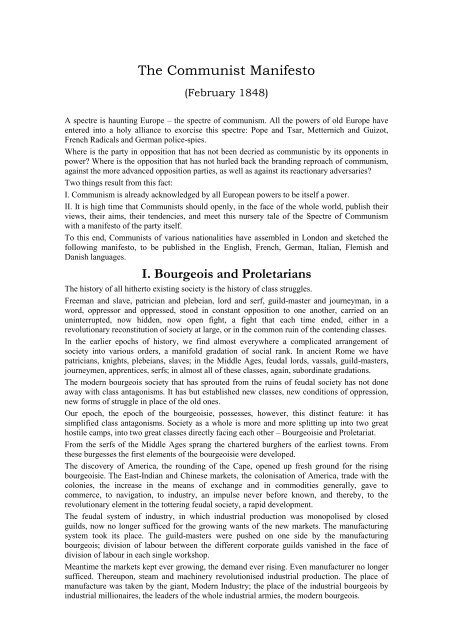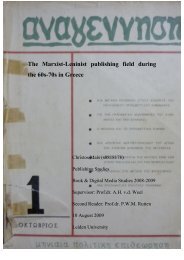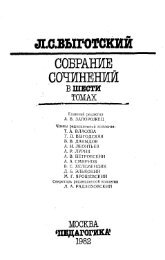The Communist Manifesto(February 1848)A spectre is haunting Europe – the spectre <strong>of</strong> communism. All the powers <strong>of</strong> old Europe haveentered into a holy alliance to exorcise this spectre: Pope and Tsar, Metternich and Guizot,French Radicals and German police-spies.Where is the party in opposition that has not been decried as communistic by its opponents inpower? Where is the opposition that has not hurled back the branding reproach <strong>of</strong> communism,against the more advanced opposition parties, as well as against its reactionary adversaries?Two things result from this fact:I. Communism is already acknowledged by all European powers to be itself a power.II. It is high time that Communists should openly, in the face <strong>of</strong> the whole world, publish theirviews, their aims, their tendencies, and meet this nursery tale <strong>of</strong> the Spectre <strong>of</strong> Communismwith a manifesto <strong>of</strong> the party itself.To this end, Communists <strong>of</strong> various nationalities have assembled in London and sketched thefollowing manifesto, to be published in the English, French, German, Italian, Flemish andDanish languages.I. Bourgeois and ProletariansThe history <strong>of</strong> all hitherto existing society is the history <strong>of</strong> class struggles.Freeman and slave, patrician and plebeian, lord and serf, guild-master and journeyman, in aword, oppressor and oppressed, stood in constant opposition to one another, carried on anuninterrupted, now hidden, now open fight, a fight that each time ended, either in arevolutionary reconstitution <strong>of</strong> society at large, or in the common ruin <strong>of</strong> the contending classes.In the earlier epochs <strong>of</strong> history, we find almost everywhere a complicated arrangement <strong>of</strong>society into various orders, a manifold gradation <strong>of</strong> social rank. In ancient Rome we havepatricians, knights, plebeians, slaves; in the Middle Ages, feudal lords, vassals, guild-masters,journeymen, apprentices, serfs; in almost all <strong>of</strong> these classes, again, subordinate gradations.The modern bourgeois society that has sprouted from the ruins <strong>of</strong> feudal society has not doneaway with class antagonisms. It has but established new classes, new conditions <strong>of</strong> oppression,new forms <strong>of</strong> struggle in place <strong>of</strong> the old ones.Our epoch, the epoch <strong>of</strong> the bourgeoisie, possesses, however, this distinct feature: it hassimplified class antagonisms. Society as a whole is more and more splitting up into two greathostile camps, into two great classes directly facing each other – Bourgeoisie and Proletariat.From the serfs <strong>of</strong> the Middle Ages sprang the chartered burghers <strong>of</strong> the earliest towns. Fromthese burgesses the first elements <strong>of</strong> the bourgeoisie were developed.The discovery <strong>of</strong> America, the rounding <strong>of</strong> the Cape, opened up fresh ground for the risingbourgeoisie. The East-Indian and Chinese markets, the colonisation <strong>of</strong> America, trade with thecolonies, the increase in the means <strong>of</strong> exchange and in commodities generally, gave tocommerce, to navigation, to industry, an impulse never before known, and thereby, to therevolutionary element in the tottering feudal society, a rapid development.The feudal system <strong>of</strong> industry, in which industrial production was monopolised by closedguilds, now no longer sufficed for the growing wants <strong>of</strong> the new markets. The manufacturingsystem took its place. The guild-masters were pushed on one side by the manufacturingbourgeois; division <strong>of</strong> labour between the different corporate guilds vanished in the face <strong>of</strong>division <strong>of</strong> labour in each single workshop.Meantime the markets kept ever growing, the demand ever rising. Even manufacturer no longersufficed. Thereupon, steam and machinery revolutionised industrial production. The place <strong>of</strong>manufacture was taken by the giant, Modern Industry; the place <strong>of</strong> the industrial bourgeois byindustrial millionaires, the leaders <strong>of</strong> the whole industrial armies, the modern bourgeois.
Modern industry has established the world market, for which the discovery <strong>of</strong> America pavedthe way. This market has given an immense development to commerce, to navigation, tocommunication by land. This development has, in its turn, reacted on the extension <strong>of</strong> industry;and in proportion as industry, commerce, navigation, railways extended, in the same proportionthe bourgeoisie developed, increased its capital, and pushed into the background every classhanded down from the Middle Ages.We see, therefore, how the modern bourgeoisie is itself the product <strong>of</strong> a long course <strong>of</strong>development, <strong>of</strong> a series <strong>of</strong> revolutions in the modes <strong>of</strong> production and <strong>of</strong> exchange.Each step in the development <strong>of</strong> the bourgeoisie was accompanied by a corresponding politicaladvance <strong>of</strong> that class. An oppressed class under the sway <strong>of</strong> the feudal nobility, an armed andself-governing association in the medieval commune: here independent urban republic (as inItaly and Germany); there taxable “third estate” <strong>of</strong> the monarchy (as in France); afterwards, inthe period <strong>of</strong> manufacturing proper, serving either the semi-feudal or the absolute monarchy as acounterpoise against the nobility, and, in fact, cornerstone <strong>of</strong> the great monarchies in general,the bourgeoisie has at last, since the establishment <strong>of</strong> Modern Industry and <strong>of</strong> the world market,conquered for itself, in the modern representative State, exclusive political sway. The executive<strong>of</strong> the modern state is but a committee for managing the common affairs <strong>of</strong> the wholebourgeoisie.The bourgeoisie, historically, has played a most revolutionary part.The bourgeoisie, wherever it has got the upper hand, has put an end to all feudal, patriarchal,idyllic relations. It has pitilessly torn asunder the motley feudal ties that bound man to his“natural superiors,” and has left remaining no other nexus between man and man than nakedself-interest, than callous “cash payment.” It has drowned the most heavenly ecstasies <strong>of</strong>religious fervour, <strong>of</strong> chivalrous enthusiasm, <strong>of</strong> philistine sentimentalism, in the icy water <strong>of</strong>egotistical calculation. It has resolved personal worth into exchange value, and in place <strong>of</strong> thenumberless indefeasible chartered freedoms, has set up that single, unconscionable freedom –Free Trade. In one word, for exploitation, veiled by religious and political illusions, it hassubstituted naked, shameless, direct, brutal exploitation.The bourgeoisie has stripped <strong>of</strong> its halo every occupation hitherto honoured and looked up towith reverent awe. It has converted the physician, the lawyer, the priest, the poet, the man <strong>of</strong>science, into its paid wage labourers.The bourgeoisie has torn away from the family its sentimental veil, and has reduced the familyrelation to a mere money relation.The bourgeoisie has disclosed how it came to pass that the brutal display <strong>of</strong> vigour in theMiddle Ages, which reactionaries so much admire, found its fitting complement in the mostslothful indolence. It has been the first to show what man’s activity can bring about. It hasaccomplished wonders far surpassing Egyptian pyramids, Roman aqueducts, and Gothiccathedrals; it has conducted expeditions that put in the shade all former Exoduses <strong>of</strong> nations andcrusades.The bourgeoisie cannot exist without constantly revolutionising the instruments <strong>of</strong> production,and thereby the relations <strong>of</strong> production, and with them the whole relations <strong>of</strong> society.Conservation <strong>of</strong> the old modes <strong>of</strong> production in unaltered form, was, on the contrary, the firstcondition <strong>of</strong> existence for all earlier industrial classes. Constant revolutionising <strong>of</strong> production,uninterrupted disturbance <strong>of</strong> all social conditions, everlasting uncertainty and agitationdistinguish the bourgeois epoch from all earlier ones. All fixed, fast-frozen relations, with theirtrain <strong>of</strong> ancient and venerable prejudices and opinions, are swept away, all new-formed onesbecome antiquated before they can ossify. All that is solid melts into air, all that is holy ispr<strong>of</strong>aned, and man is at last compelled to face with sober senses his real conditions <strong>of</strong> life, andhis relations with his kind.The need <strong>of</strong> a constantly expanding market for its products chases the bourgeoisie over theentire surface <strong>of</strong> the globe. It must nestle everywhere, settle everywhere, establish connectionseverywhere.The bourgeoisie has through its exploitation <strong>of</strong> the world market given a cosmopolitan characterto production and consumption in every country. To the great chagrin <strong>of</strong> Reactionists, it hasdrawn from under the feet <strong>of</strong> industry the national ground on which it stood. All old-established
- Page 4: égime, which has been through its
- Page 7: sins of all state forms. That this
- Page 13 and 14: It has not occurred to any one of t
- Page 15 and 16: gradually accumulated small capital
- Page 17 and 18: from this nonsensical ‘prehistory
- Page 19 and 20: property: the nucleus, the first fo
- Page 21 and 22: which produces in all nations simul
- Page 23 and 24: [8. The Inconsistency of the Ideali
- Page 25 and 26: The ‘essence’ of the fish is it
- Page 27 and 28: hence of the relationships which ma
- Page 29 and 30: labour. In the first case, therefor
- Page 31 and 32: production and commerce soon calls
- Page 33 and 34: period begins with the Navigation L
- Page 35 and 36: more advanced countries, still have
- Page 37 and 38: over against the individuals, so th
- Page 39 and 40: eality is only a product of the pre
- Page 41 and 42: never became more than a city; its
- Page 43: Only at this stage does self-activi
- Page 47 and 48: these crises, there breaks out an e
- Page 49 and 50: Further, as we have already seen, e
- Page 51 and 52: abolish that; the development of in
- Page 53 and 54: For the rest, nothing is more ridic
- Page 55 and 56: III. Socialist and Communist Litera
- Page 57 and 58: conscious of having overcome “Fre
- Page 59 and 60: The undeveloped state of the class
- Page 61 and 62: The Paris CommuneAddress to the Int
- Page 63 and 64: priests were sent back to the reces
- Page 65 and 66: pregnant. In the full consciousness
- Page 67 and 68: subjected Versailles and the rest o
- Page 69 and 70: The Eighteenth Brumaire of Louis Bo
- Page 71 and 72: For the rest, every fair observer,
- Page 73 and 74: that here “bourgeois republic”
- Page 75 and 76: Eternalization of historic relation
- Page 77 and 78: and becomes a direct object and ser
- Page 79 and 80: each supplies the other with its ob
- Page 81 and 82: generally. The question evidently b
- Page 83 and 84: is thus the only reality, the movem
- Page 85 and 86: smudge over all historical differen
- Page 87 and 88: elations. Thus e.g. the relation of
- Page 89 and 90: a rise of wages, because every reac
- Page 91 and 92: equally spent upon all articles of
- Page 93 and 94: Apart from some years of failing ha
- Page 95 and 96:
enable a currency to adapt itself t
- Page 97 and 98:
Smith and his French predecessors h
- Page 99 and 100:
conditions of production, with a gi
- Page 101 and 102:
in a commodity constitutes its valu
- Page 103 and 104:
y working which the working man wou
- Page 105 and 106:
just seen that the surplus value co
- Page 107 and 108:
increased value of his labour, like
- Page 109 and 110:
altogether, is sure to have his wag
- Page 111 and 112:
theory, which consists in putting a
- Page 113 and 114:
Preface to A Contribution to the Cr
- Page 115 and 116:
Capital, Volume I (1867)From the Pr
- Page 117 and 118:
A use value, or useful article, the
- Page 119 and 120:
imposed necessity, without which th
- Page 121 and 122:
embodiments of one identical social
- Page 123 and 124:
abstract. The twofold social charac
- Page 125 and 126:
ased on the production of commoditi
- Page 127 and 128:
Capital Vol. III. Chapter 2. The Ra
- Page 129 and 130:
specific relationship to surplus-va














![tyf Enf=O=n]lgg](https://img.yumpu.com/47584932/1/190x245/tyf-enfonlgg.jpg?quality=85)

